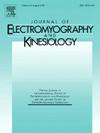Impact of age on muscle and kinematic responses to an obstacle trip while walking
IF 2.3
4区 医学
Q3 NEUROSCIENCES
引用次数: 0
Abstract
Introduction
This study examined the impact of age on muscle and kinematic responses to an obstacle trip while walking.
Materials and Methods
102 older (65–90 years) and 26 young (21–35 years) people were unexpectedly tripped using a pop-up obstacle that contacted their left foot while walking on an 8-m walkway. Kinematics and lower limb muscle responses during the first and second recovery steps were measured.
Results
Following a trip, older people more often lowered their tripped foot before the obstacle and fell into the harness, compared to young (P < 0.05). When the tripped foot was immediately lifted over the obstacle, older people showed greater co-contraction of ankle muscles and faster peak activation of plantar-flexors but slower, shorter and lower recovery steps than young (P < 0.01). When the tripped foot was immediately lowered, despite similar muscle responses, older people took shorter and lower steps to clear the obstacle and were less stable than young (P < 0.01).
Conclusions
Lower-limb muscle responses to an obstacle trip in older people may be quick but inefficient (co-contraction), resulting in poorer recovery steps and more falls compared to young people. Exercise interventions should aim to improve muscle capacity and motor skills required to prevent falls following unexpected trips.
年龄对肌肉的影响和行走时对障碍的运动反应
本研究考察了年龄对行走障碍时肌肉和运动学反应的影响。材料与方法102名老年人(65-90岁)和26名年轻人(21-35岁)在一条8米长的人行道上行走时,意外地被一个与左脚接触的弹出式障碍物绊倒。在第一和第二恢复步骤测量运动学和下肢肌肉反应。结果:与年轻人相比,老年人在旅行结束后,更经常在障碍物前放下绊倒的脚,掉进安全带里。0.05)。当绊倒的脚立即越过障碍物时,老年人表现出更大的踝关节肌肉共同收缩和更快的足底屈肌峰值激活,但比年轻人更慢,更短,更低的恢复步骤(P <;0.01)。当被绊倒的脚被立即放下时,尽管肌肉反应相似,但老年人清除障碍的步伐更短、更低,而且比年轻人更不稳定(P <;0.01)。结论与年轻人相比,老年人下肢肌肉对障碍绊倒的反应可能是快速而低效的(共收缩),导致恢复步骤较差,摔倒较多。运动干预应旨在提高肌肉能力和运动技能,以防止意外旅行后跌倒。
本文章由计算机程序翻译,如有差异,请以英文原文为准。
求助全文
约1分钟内获得全文
求助全文
来源期刊
CiteScore
4.70
自引率
8.00%
发文量
70
审稿时长
74 days
期刊介绍:
Journal of Electromyography & Kinesiology is the primary source for outstanding original articles on the study of human movement from muscle contraction via its motor units and sensory system to integrated motion through mechanical and electrical detection techniques.
As the official publication of the International Society of Electrophysiology and Kinesiology, the journal is dedicated to publishing the best work in all areas of electromyography and kinesiology, including: control of movement, muscle fatigue, muscle and nerve properties, joint biomechanics and electrical stimulation. Applications in rehabilitation, sports & exercise, motion analysis, ergonomics, alternative & complimentary medicine, measures of human performance and technical articles on electromyographic signal processing are welcome.

 求助内容:
求助内容: 应助结果提醒方式:
应助结果提醒方式:


